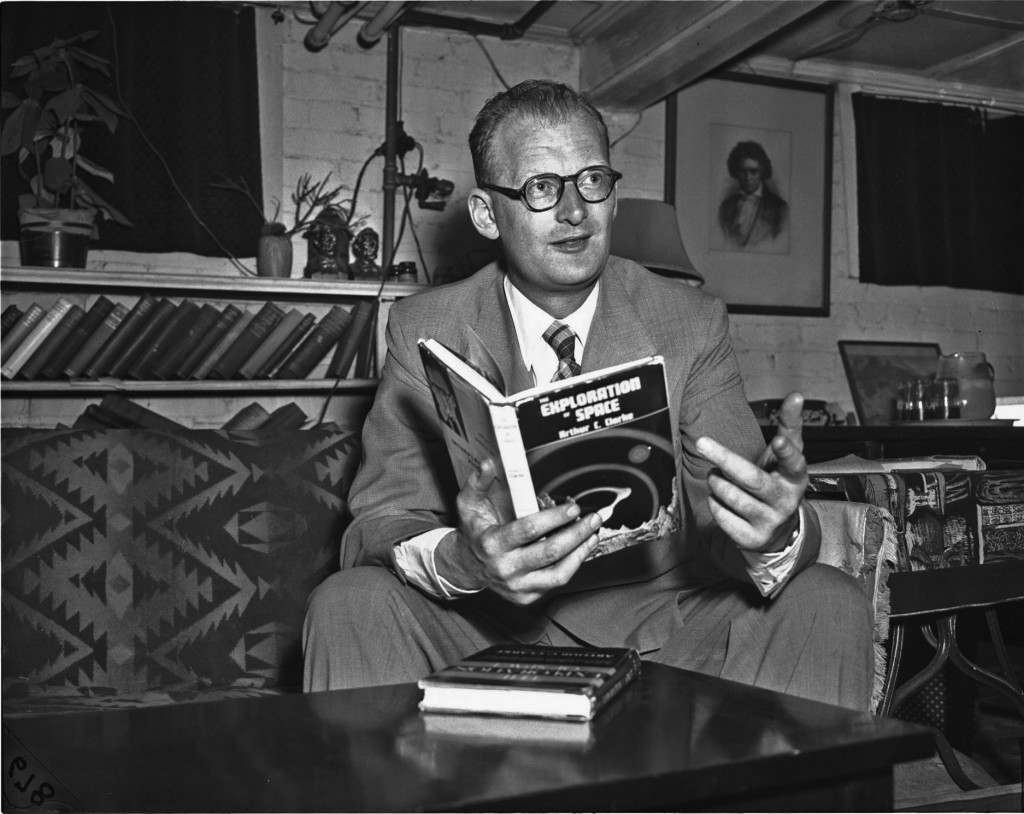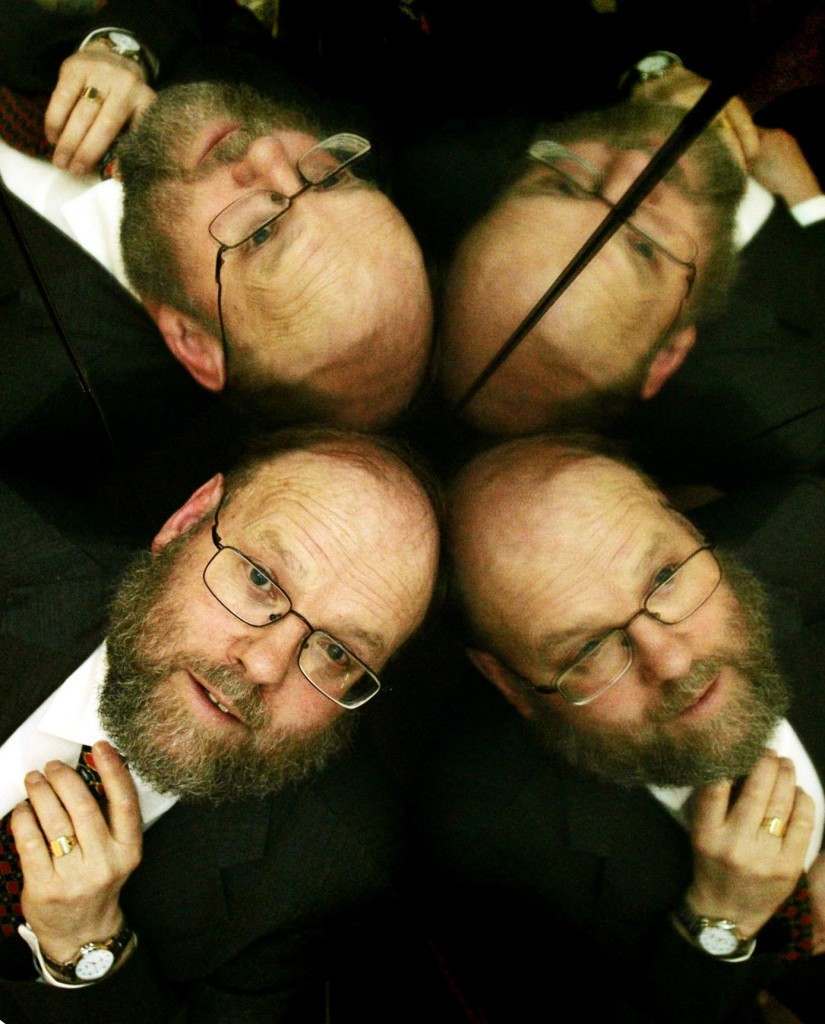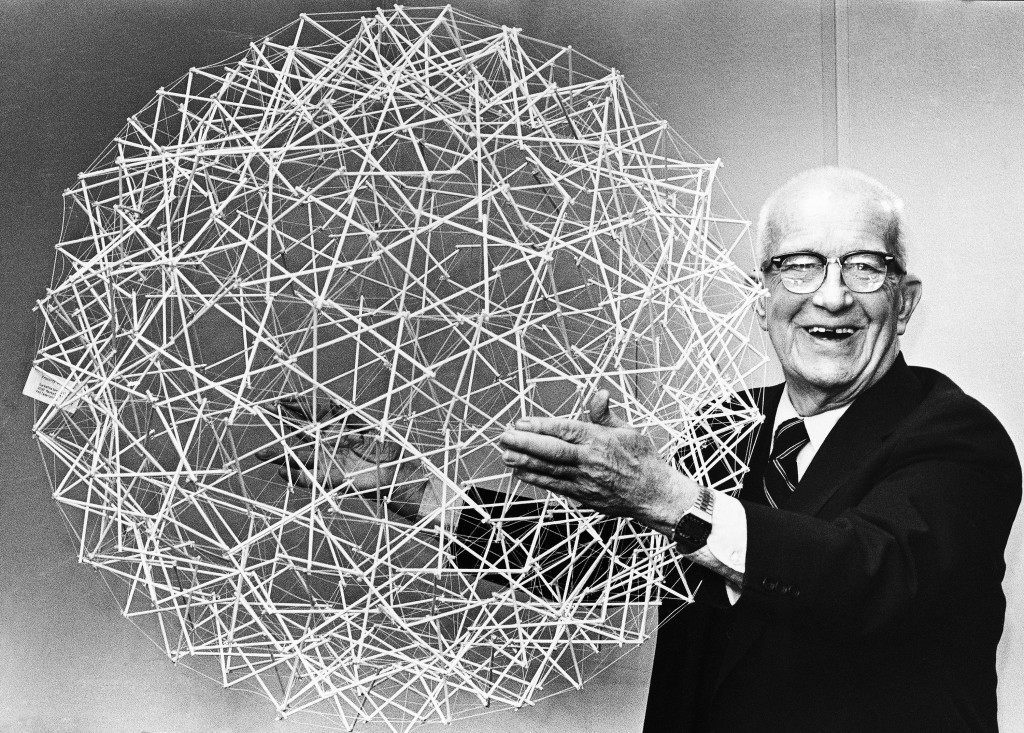
Science fiction author Arthur C. Clarke holds a copy of his book, “Exploration of Space” at a home in Washington, D.C., in this June 9, 1952 file photo.
In 2001 (obviously, he did write 2001: A Space Odyssey), Arthur C. Clarke shared with Reader’s Digest readers his vision of life in 2100.
Before we read that forecast, we can hear what Clarke saw when he looked into the future on the 1964 BBC show Horizon. He said:
“If by some miracle some prophet could describe the future exactly as it was going to take place, his predictions would sound so absurd, so far-fetched that everyone would laugh him to scorn.”
Some of what he said was prescient:
“These things will make possible a world in which we can be in instant contact wherever we may be. Where we can contact our friends anywhere on earth, even if we don’t know their actual physical location. It will be possible in that age, possibly 50 years from now, for a man to conduct his business from Tahiti or Bali just as well as he could from London.”
We still don’t have monkey servants (and by ‘we’ I mean anyone outside the Royal Family). But Clarke could see the power of the remote communication, computing and 3D printing making us lazy and avaricious.
So much for 1964. What of his words form 2001?
- Sir Arthur C. Clarke:No one can see into the future. What I try to do is outline possible “futures” – although totally expected inventions or events can render predictions absurd after only a few years. The classic example is the statement, made in the late 1940s, by the then chairman of IBM that the world market for computers was five. I have more than that in my own office.
Perhaps I am in no position to criticise: in 1971 I predicted the first Mars Landing in 1994; now we’ll be lucky if we make it by 2010. On the other hand, I thought I was being wildly optimistic in 1951 by suggesting a mission to the moon in 1978. Neil Armstrong and Buzz Aldrin beat me by almost a decade.
Still, I take pride in the fact that communications satellites are placed exactly where I suggested in 1945, and the name “Clarke Orbit” is often used (if only because it’s easier to say than “geostationary orbit”).
Some of the event listed here, particularly the space missions, are already scheduled. I believe all the other events could happen, although several, I hope, will not. Check me for accuracy – on December 31, 2100.
2001 Cassini space probe (launched 1997) begins exploration of Saturn’s moons and rings. Galileo probe (launched 1989) continues surveying Jupiter and its moons. Life beneath the ice-covered oceans of one moon, Europa, appears likely.
2002 The first commercial device producing clean, safe power by low-temperate nuclear reactions goes on the market, heralding the end of the Fossil Fuel Age.
2003 The motor industry is given five years to replace all fuel-burning engines with the new energy device. The same year, NASA’s robot Mars Surveyor is launch

Professor Ian Wilmut part of research team based at the Roslin Instistute near Edinburgh have been granted a licence by the Human Fertilisation and Embryology Authority (HFEA) to clone human Embryos for research that may one day help find a cure for Motor Neurone disease. However, expert Dr Donald Bruce said there was a “significant danger” that maverick scientists would misuse technology to clone babies.
- 2004 First (publicly admitted) human clone.
- 2005 First sample sent back to Earth by Mars Surveyor.2006 Last coal mine closed.
2008 A city in a developing country is devastated by the accidental detonation of an atomic bomb in its armoury. After a brief debate in the United Nations, all nuclear weapons are destroyed.
2009 The first quantum generators (tapping space energy) are developed. Available in portable and household units, from a few kilowatts upwards, they can produce electricity indefinitely. Central power stations close down: the age of pylons ends.
Electronic monitoring virtually phases out professional criminals.
2011 Largest living animal filmed: a 76-metre octopus in the Mariana Trench. By coincidence, even larger creatures are then discovered when the first robot probes drill through the ice of Europa.
2012 Aerospace-planes enter commercial service.
2013 Prince Harry becomes the first member of the British royal family to fly in space.
2014 Construction of Hilton Orbiter Hotel begins by converting the giant shuttle tanks previously allowed to fall back to Earth.
2015 An inevitable by-product of the quantum generator is complete control of matter at the atomic level. Within a few years, because they are more useful, lead and copper cost twice as much as gold.
2016 Existing currencies are abolished. The “mega-watt-hour” becomes the universal unit of exchange.
2017 On his hundred birthday, December 16, Sir Arthur C. Clarke is one of the first guests in the Hilton Orbiter.
2019 A major meteor impact occurs on the north polar ice cap. The resulting tsunamis cause considerable damage along the coasts of Greeland and Canada. The long-discussed “Project Spaceguard,” to identify and deflect potentially dangerous comets or asteroids, is finally activated.
2020 Artificial Intelligence reaches human level. From now on there are two intelligent species on Earth.

JoJo Aguilar, a Mars exploration team member, dusts a full-scale model of the Phoenix lander Thursday, May 22, 2008, at NASA’s Jet Propulsion Laboratory in Pasadena, Calif. The lander will reach Mars on Sunday, May 25, to begin a three-month mission studying an arctic site on the Red Planet. (AP Photo/Ric Francis)
- 2021 The first humans land on Mars.2023 Dinosaur facsimiles are cloned from computer-generated DNA.
2024 Infrared signals are detected coming from the centre of the Galaxy, obviously the product of a technologically advanced civilisation. All attempts to decipher them fail.
2025 Neurological research finally leads to an understanding of all the senses, and direct input becomes possible, bypassing ears, eyes, skin, etc. The result is the metal “Braincap.” Anyone wearing this close-fitting helmet can enter a whole universe of experience, real or imaginary.
The Braincap is a boon to doctors, who can now experience their patients’ symptoms (suitable attenuated). It also revolutionises the legal profession, as deliberate lying is now impossible.
2040 The “Universal Replicator,” based on nanotechnology, is perfected: any object, however complex, can be created – given the necessary raw materials. Diamonds or gourmet meals can, literally, be made from dirt.
As a result, agriculture and industry are phased out – along with work. There is an explosion in the arts, entertainment and education. Hunter-gathere societies are deliberately recreated, with huge areas of the planet allowed to revert to their natural state.

In a Philadelphia, United States, office, on April 18, 1979 R. Buckminster Fuller holds up a Tensegrity sphere – one of his inventions thatÂs inspired a space project. Dr. Ernest Okress of the Franklin Center envisions the structure, made of rods and cables, as the basis for a Spherical Tensegrity Atmospheric Research Station  STARS. A giant Tensegrity sphere could be light and strong enough to support a floating space station a mile in diameter. (AP Photo/WGI)
-
2045 The totally self-contained mobile home (envisaged almost a century ago by Buckminster Fuller) is perfected. Any additional carbon needed from food synthesis is obtained by extracting carbon dioxide from the atmosphere.
2050 Bored in this era, millions decide to use cryonic suspension to emigrate into the future in search of adventure.
2057 On October 4, the centenary of Sputnik 1, the dawn of the space age is celebrated by humans on Earth, the Moon, Mars, Europa, Ganymede and Titan, and in orbit around Venus, Neptune and Pluto.
2061 Halley’s Comet returns – first landing by humans, And the sensational discovery of both dormant and active life forms vindicates Wickramasinghe and Hoyle’s century-old hypothesis that life exists through space.
2090 Burning of fossil fuels is resumed to replace carbon dioxide “mined” from the air and to try to postpone the next Ice Age by promoting global warming.
2095 The development of a “Space Drive” – a propulsion system reacting against the structure of space-time – makes the rocket obsolete and permits velocities close to that of light. Human explorers set off to nearby star systems.
2100 History begins…
But dude, where’s my flying car..?
Would you like to support Flashbak?
Please consider making a donation to our site. We don't want to rely on ads to bring you the best of visual culture. You can also support us by signing up to our Mailing List. And you can also follow us on Facebook, Instagram and Twitter. For great art and culture delivered to your door, visit our shop.

